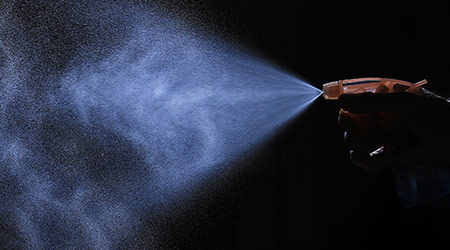
New device diffuses viscous disinfectants
Standard mechanical atomization doesn't work well with viscous fluids
A new device created by engineers and scientists in San Diego can diffuse potent viscous disinfectants for airborne delivery, according to an article on the Infection Control Today website.
In a study published in Applied Microbiology and Biotechnology, the device was used to atomize disinfectants onto surfaces contaminated with bacteria. It eliminated 100 percent of bacteria that commonly cause hospital-acquired infections (HAIs). In the same study, an atomized bleach solution eliminated drug resistant strains of bacteria including K. pneumoniae.
Researchers built the device using smartphone components that produce acoustic waves. The components were used to generate sound waves at extremely high frequencies to cause atomization — the creation of fluid capillary waves, which in turn emit droplets and generate mist.
Standard mechanical atomization doesn't work well with viscous fluids. It either requires too much power, expensive equipment or breaks down some of the fluids' active ingredients.
The smart phone components use a material that produces more energy efficient and reliable ultrasonic vibrations, so the device can atomize even the most viscous fluids into a fine mist that can drift in the air for more than an hour.
Researchers are working on an updated prototype to use in healthcare facilities. The device eventually could be used in airports, airplanes and in public transportation.
August 9, 2018
Topic Area: Infection Control
Recent Posts
 Joint Commission Standards: What Updates Matter Most?
Joint Commission Standards: What Updates Matter Most?
The latest revisions are streamlined and aligned with the Centers for Medicare and Medicaid Services, but the facility manager’s learning curve is steep.
 Swinerton Completes Construction at Atlanta's Grady Hospital
Swinerton Completes Construction at Atlanta's Grady Hospital
Projects mark Swinerton’s first partnership with Georgia’s largest hospital.
 NY Governor Hochul Announces $300M in Funds for IT and Cybersecurity
NY Governor Hochul Announces $300M in Funds for IT and Cybersecurity
Awardees include hospitals in every region of the state.
 Healthcare Is the New Retail
Healthcare Is the New Retail
How site selection strategies are shaping the future of medical real estate.
 Bridgeway Behavioral Health Services Launches Campaign to Renovate Health Center
Bridgeway Behavioral Health Services Launches Campaign to Renovate Health Center
The $2 million capital campaign aims to renovate and expand the outpatient behavioral health center in Elizabeth, New Jersey.